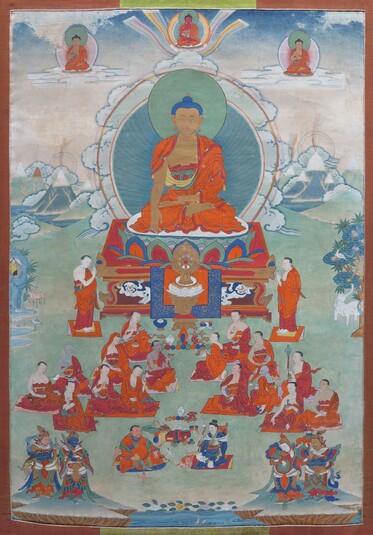
Item: Shakyamuni Buddha - with Sixteen Elders (Arhats)
| Origin Location | Tibet |
|---|---|
| Date Range | 1800 - 1899 |
| Lineages | Karma (Kagyu) and Buddhist |
| Material | Ground Mineral Pigment on Cotton |
| Collection | Private |
Classification: Person
Appearance: Buddha
Gender: Male
Shakyamuni Buddha (Tibetan: sha kya thu pa, English: Sage of the Shakya Clan) along with the Two Principle Disciples, the Sixteen Elders, Two Attendants and the Four Guardian Kings of the Directions. In total there are twenty-five figures which make up this iconographic group of figures. At the top are three Buddhas, Amitabha, Dipamkara and Maitreya. (See another painting in the painting with the same basic composition).
Sanskrit: Buddha Shakyamuni Tibetan: Sang gye sha kya tu pa
Tibetan: Sang gye sha kya tu pa
Golden in colour with one face and two hands, he has blue-black hair in a top-knot crowned with a gold ornament, long split ears and an upper robe covering the right shoulder with the length of the arm bare. The legs are folded with the two feet resting on the opposite thighs in vajra posture. He wears upper and lower robes of patched strips of cloth, orange and red in colour. The right hand is placed with the palm down across the knee in the mudra (gesture) calling the Earth to witness his moment of enlightenment. The left hand rests in the lap in the mudra of meditation. Well composed, surrounded by a nimbus of fine light rays forming a rainbow sphere and a green areola, he sits above a moon disc and multi-coloured lotus atop a lion supported throne. Standing at the left side is the monk Shariputra with Maudgalyayana to the left, both with the hands respectfully folded. On a table in front a golden Dharma wheel is placed atop a pink lotus with various offerings such as a begging bowl, bolts of cloth, wishing jewels, a conch shell and red coral arranged on the ground in front.
At the top center is the buddha Amitabha, red, holding a begging bowl in the lap. At the left is the buddha of the previous age, Dipamkara. At the right is the buddha of the next age, Maitreya.
Seated below the throne, along each side, are the 16 Arhats - outstanding students of Shakyamuni buddha. Each carries their own recognizable symbol or performs a unique mudra, all wear monastic robes. At the lower center are the two attendants to the 16 Arhats. On the left is Hvashang, plump, well attired in various robes and surrounded by playful children. On the right is Dharmatala, seated upright in a chair and accompanied by a tiger.
At the bottom corners stand the 4 Guardians of the Directions. On the left is Virupaksha, red in colour, holding a chaitya (reliquary symbol). Next is Virudhaka, blue, holding a sword. On the right is Dhritarashtra, white, holding a lute. In the corner is the leader, Vaishravana, yellow, holding a victory banner. All wear protective armour and multi-coloured robes.
The painting is from Eastern Tibet, Kham Province, and follows the unique painting style of Palpung Monastery created under the patronage of Situ Panchen Chokyi Jungne.
There are five different appearances represented in this composition: Buddha, Arhat, King and Lay Person. Arhat Appearance and Monastic Appearance can be identical in some iconographic situations. The context and subject of the painting becomes very important in these situations.
This composition is made up of several different iconographic number sets:
1. The Buddhas of the Three Times
2. Shakyamuni Buddha and the Two Principal Disciples
3. Shakyamuni Buddha and the Sixteen Elders
4. The Two Attendant to the Sixteen Elders
5. The Four Guardian Kings
Jeff Watt 12-2015 [based on HAR #414]
Buddha Form | Female Form | Wrathful Form
Exhibition: Buddha Form (DM)
Shakyamuni Buddha: Main Page
Collection of Dhargye Museum
Collection of Dhargye Museum (Painting Gallery 2)

